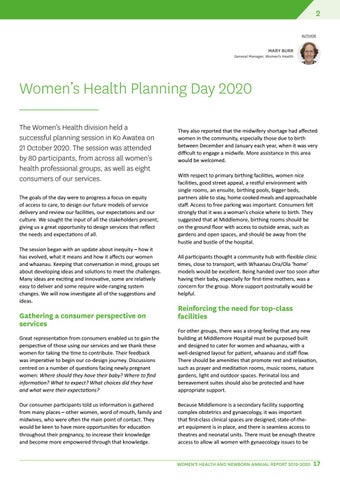2 AUTHOR
MARY BURR
General Manager, Women’s Health
Women’s Health Planning Day 2020 The Women’s Health division held a successful planning session in Ko Awatea on 21 October 2020. The session was attended by 80 participants, from across all women’s health professional groups, as well as eight consumers of our services. The goals of the day were to progress a focus on equity of access to care, to design our future models of service delivery and review our facilities, our expectations and our culture. We sought the input of all the stakeholders present, giving us a great opportunity to design services that reflect the needs and expectations of all. The session began with an update about inequity – how it has evolved, what it means and how it affects our women and whaanau. Keeping that conversation in mind, groups set about developing ideas and solutions to meet the challenges. Many ideas are exciting and innovative, some are relatively easy to deliver and some require wide-ranging system changes. We will now investigate all of the suggestions and ideas.
Gathering a consumer perspective on services
They also reported that the midwifery shortage had affected women in the community, especially those due to birth between December and January each year, when it was very difficult to engage a midwife. More assistance in this area would be welcomed. With respect to primary birthing facilities, women nice facilities, good street appeal, a restful environment with single rooms, an ensuite, birthing pools, bigger beds, partners able to stay, home cooked meals and approachable staff. Access to free parking was important. Consumers felt strongly that it was a woman’s choice where to birth. They suggested that at Middlemore, birthing rooms should be on the ground floor with access to outside areas, such as gardens and open spaces, and should be away from the hustle and bustle of the hospital. All participants thought a community hub with flexible clinic times, close to transport, with Whaanau Ora/Ola ‘home’ models would be excellent. Being handed over too soon after having their baby, especially for first-time mothers, was a concern for the group. More support postnatally would be helpful.
Reinforcing the need for top-class facilities
Great representation from consumers enabled us to gain the perspective of those using our services and we thank these women for taking the time to contribute. Their feedback was imperative to begin our co-design journey. Discussions centred on a number of questions facing newly pregnant women: Where should they have their baby? Where to find information? What to expect? What choices did they have and what were their expectations?
For other groups, there was a strong feeling that any new building at Middlemore Hospital must be purposed built and designed to cater for women and whaanau, with a well-designed layout for patient, whaanau and staff flow. There should be amenities that promote rest and relaxation, such as prayer and meditation rooms, music rooms, nature gardens, light and outdoor spaces. Perinatal loss and bereavement suites should also be protected and have appropriate support.
Our consumer participants told us information is gathered from many places – other women, word of mouth, family and midwives, who were often the main point of contact. They would be keen to have more opportunities for education throughout their pregnancy, to increase their knowledge and become more empowered through that knowledge.
Because Middlemore is a secondary facility supporting complex obstetrics and gynaecology, it was important that first-class clinical spaces are designed, state-of-theart equipment is in place, and there is seamless access to theatres and neonatal units. There must be enough theatre access to allow all women with gynaecology issues to be WOMEN'S HEALTH AND NEWBORN ANNUAL REPORT 2019-2020 17






















